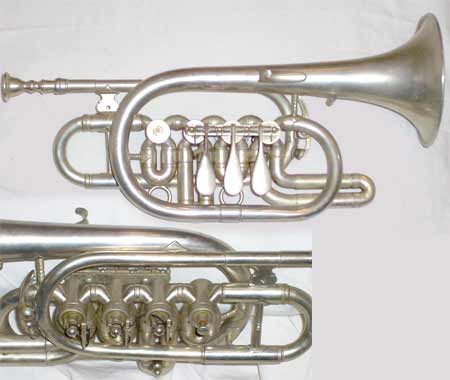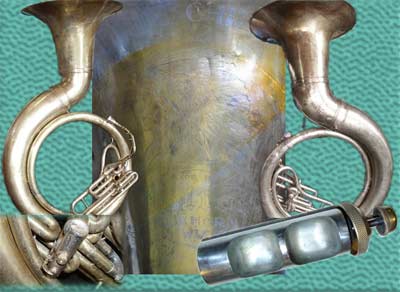Page 1 of 2
Re: weird *** valves !
Posted: Wed Apr 20, 2011 11:53 pm
by Dan Schultz
Horns with smaller bores have shorter strokes. This version utilized two small ports dumping into one larger tube. Conn had their 'squashed' bugle port that had the same cross-section area as the bore.
Re: weird *** valves !
Posted: Thu Apr 21, 2011 1:46 am
by imperialbari
Detune the parallel loops and you have an early chorus effect. Maybe even beats percussive enough to count as an on-board rhythm box. Another way of making your bass section sound bigger, as these effects take at least two instruments and two players, if both categories are normal.
The seller wonders why this instrument looks that fresh and unused. Small wonder: it is useless.
ART: All Retarded Tuba!
Klaus
Re: weird *** valves !
Posted: Thu Apr 21, 2011 9:40 am
by iiipopes
Nice idea, but looks like something to make maintenance just that much more of a nightmare.
Re: weird *** valves !
Posted: Thu Apr 21, 2011 10:06 am
by bbocaner
imperialbari wrote:Detune the parallel loops and you have an early chorus effect.
I'm sure you're just joking, but it doesn't work like that. Since your lips are only buzzing at one frequency, putting it through two paths of unequal length will not result in two pitches but just a pitch that doesn't "slot" very well.
Re: weird *** valves !
Posted: Thu Apr 21, 2011 10:32 am
by windshieldbug
KiltieTuba wrote:Someone care to explain the TWO second valve slides on opposite sides of the valve casing?
It turns out that volume is as important as length.
And no, I'm not going to make a "At least that what she explained" joke.

Re: weird *** valves !
Posted: Fri Apr 22, 2011 9:16 pm
by Dan Schultz
goodgigs wrote:Sorry, but I'm not done with this topic !
I want to hear how it is possible to combine, let alone split two sound columns, and get anything like music ?
I also want to know how it would be possible to put two out of tune columns together and still have the same note ?
Thirdly, to heck with the hypothetical, who's played one of these rare birds ? I remember someone said that they
had played the recording bass version that was discussed two or three years ago. Who ever you are, fess up !
This guy may have some of it figured out. Makes sense to me....
viewtopic.php?f=2&t=44121#p381477
Re: weird *** valves !
Posted: Sat Apr 23, 2011 3:25 am
by imperialbari
Of course I don’t have the concrete brain of Rick Denney. Still:
This Buescher idea is born sick. Making one single bore optimal for a whole lot of permutations of standing waves as needed for a decent range of decently sounding notes with all odd valve permutations imaginable is a demanding task in itself. Adjusting splits and joints to minimize turbulences and sync of phases is much worse.
If this concept had been of musical value, it would have survived. It may have had another function, however. I don’t know the exact timeline of this Buescher patent in relation to the short action concepts of Conn and Holton, but Buescher’s idea of lowering the roof of the tubing and widening it (here by doubling) could have inspired Conn and Holton into doing the same without doubling, but by flattening the valve entries and exits in the passage of the main bugle through the valve block. At least Conn has the normal circular ports for the valve loops. The shape transition happens in the inner-piston knuckles (or whatever the correct term might be).
Klaus
Re: weird *** valves !
Posted: Sat Apr 23, 2011 1:55 pm
by Dan Schultz
During the first half of the last century... most all manufacturers (not just music instrument) were scrambling for market share and spent a great deal of time cranking out worthless patents.... just to keep the competition at bay. Bear in mind that as long as a US Patent is 'pending'... no information regarding the contents of the patent have to be made public. It's not until a patent is actually issued that the information is published.
I don't know if there is any truth to it. But... word is that Conn sued the rest the music community over the use of the term 'short-action'. The flurry of ideas seemed to me to all be pretty worthless with respect to the manufacturing costs over what had already been done for the earlier fifty years. Putting a hole through a piston is pretty difficult in it's own rite without 'squashed', 'scooped', or 'Siamesed' ports.
Re: weird *** valves !
Posted: Sat Apr 23, 2011 6:53 pm
by DonShirer
I would think (never having tried a valve setup like this) that if executed perfectly, it would work, but slight differences in the path length due to manufacturing errors or slide pulls might defocus the tones. Anybody played one who can comment?
And the inventor may have been ingenious, but either he doesn't know basic physics or his patent lawyer messed up, as shown by
The fundamental pitch of the instrument is determined by the cross sectional area, of the wind pipe.
And I note that in covering all bases in the patent application he claims the use of "multiple" paths through the valves. Can you imagine what a 4- (or more) path instrument might look like (or weigh!).
Re: weird *** valves !
Posted: Sat Apr 23, 2011 7:04 pm
by imperialbari
DonShirer wrote:And I note that in covering all bases in the patent application he claims the use of "multiple" paths through the valves. Can you imagine what a 4- (or more) path instrument might look like (or weigh!).
Probably would be good for Italian music. I mean from the spaghetti looks.
K
Re: weird *** valves !
Posted: Sun Apr 24, 2011 1:31 pm
by windshieldbug
goodgigs wrote:BUT in reality, I don't have a shop and to I must ask for the help of the people who have played them.
Who here has played these valves ? Who here has played 19th century Anderson valves?
BTW; About Anderson valves; I read that they went out of vogue because the Anderson family wanted
too much royalty on their patent and regular rotaries were available for large bore instruments.
Also if you think about it, tubas make up a small part of the instrument world.
Do you mean Allen "pinched" rotary valves?

That's my cornet, yes I play it all the time, and it doesn't play any better or worse than anything else that was built in that period.
I just don't think the perceived benefits justified the additional manufacturing costs.
Think of how much extra work is involved in that Buescher design, for example. To get a fraction of an inch off the throw of an instrument that doesn't double/triple tongue that often, anyway.
There are lots of ways to shorten the valve throw of any type of valve.
I'm just not sure that they justify the complications.
I actually once built a trumpet mouthpiece with two separate shanks once. But to my dismay, rather than being able to play duets with myself ala Rahsaan Roland Kirk, only one note came out of both horns. Push valves down, different note, but still the same note out of both horns. That's when I realized that it was volume, and not a single column, that was important. And that's how Buescher's valve works.
Re: weird *** valves !
Posted: Sun Apr 24, 2011 5:27 pm
by windshieldbug
Geometric volume. I suspect it's not quite that simple, but it's got to be something along those lines.
Sorry, I didn't recall having the conversation before.
Since you lasted asked about the cornet, I dug it out and have actually been using it quite a bit more. Now that I know that the 4th valve was intended for H/L pitch, I don't feel like I'm using it other than what it was intended for.
Modern manufacturing and use of plastics, etc may make the idea of a short action valve a lot more practical now.
Re: weird *** valves !
Posted: Sun Apr 24, 2011 7:36 pm
by bbocaner
goodgigs wrote:
Not to be rude here, but that doesn’t make any sense to me at all. If circuit length didn't change the tuning; we're wasting a lot of tubing on it !
There's only one thing that determines the pitch that's coming out of your bell: the frequency at which your lips are vibrating. Now, having all that tubing of a specific length and specific taper works to create resonances at specific frequencies to guide your lips into doing the right thing, creating slots at certain pitches where things lock right in and sound big and beautiful and making other pitches difficult to achieve, but at the end of the day, your lips are what does it.
Re: weird *** valves !
Posted: Sun Apr 24, 2011 7:44 pm
by Dan Schultz
bbocaner wrote:goodgigs wrote:
Not to be rude here, but that doesn’t make any sense to me at all. If circuit length didn't change the tuning; we're wasting a lot of tubing on it !
There's only one thing that determines the pitch that's coming out of your bell: the frequency at which your lips are vibrating. Now, having all that tubing of a specific length and specific taper works to create resonances at specific frequencies to guide your lips into doing the right thing, creating slots at certain pitches where things lock right in and sound big and beautiful and making other pitches difficult to achieve, but at the end of the day, your lips are what does it.
Sort of makes sense to me. At least this explains why a tuba mouthpiece won't work in a trumpet and vice-versa.
Re: weird *** valves !
Posted: Sun Apr 24, 2011 11:54 pm
by Art Hovey
Did anybody notice that it is actually a raincatcher sousaphone with its bell turned forward?
I don't see any reason why this valve system couldn't work, but I would expect it to play a bit more on the stuffy side. Although the cross-sectional area of the valve tubing is not sacrificed, the wall surface area is increased by about 41%. The vibrating air has to rub against that surface.
The cost of manufacturing the pistons would be practically doubled too.
Re: weird *** valves !
Posted: Mon Apr 25, 2011 1:17 pm
by windshieldbug
goodgigs wrote:Let me ask you the $64.00 question; can you slur notes comfortably, can you crack the valves to bend notes, if you move the valves slowly while
slurring from note to note, is all that Garbage that you hear any different then the noise you would hear from any other rotary cornet ?
Oh yeah, one last question, do these valves seem "hair triggered" at all ? That's what Peter Hurshburners' similar valves were said to be.
No real difference between the Allen an "normal" rotaries.
And no, they don't feel "hair triggered". With the side action, the travel may be a little less, but unless you've developed bad habits with your fingers, I don't know why they would. Of course, I'm used to playing many different instruments with different thows in the action, or perhaps I don't understand the question.
I don't remember if we've talked about this, but something to consider is Holton's version of the short-throw.
It used "pinched" ports, as well, but the air column makes a U-turn, making the piston valves as uncomplicated as a rotary...


